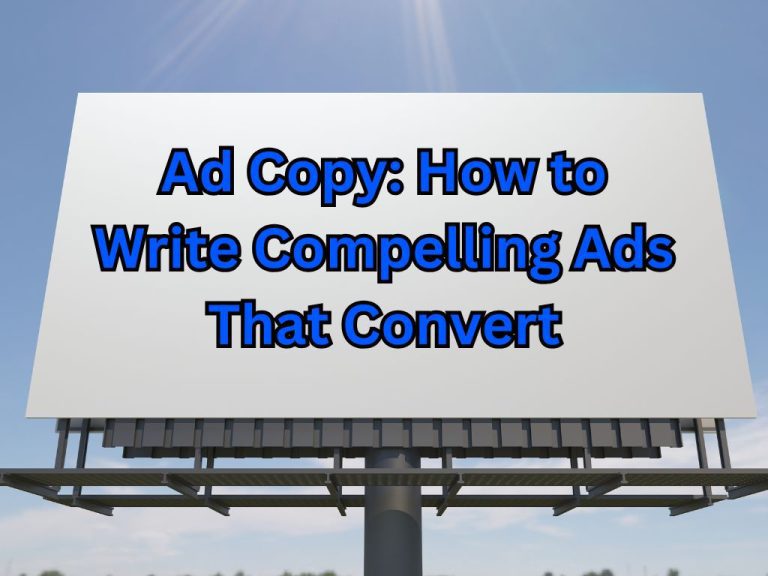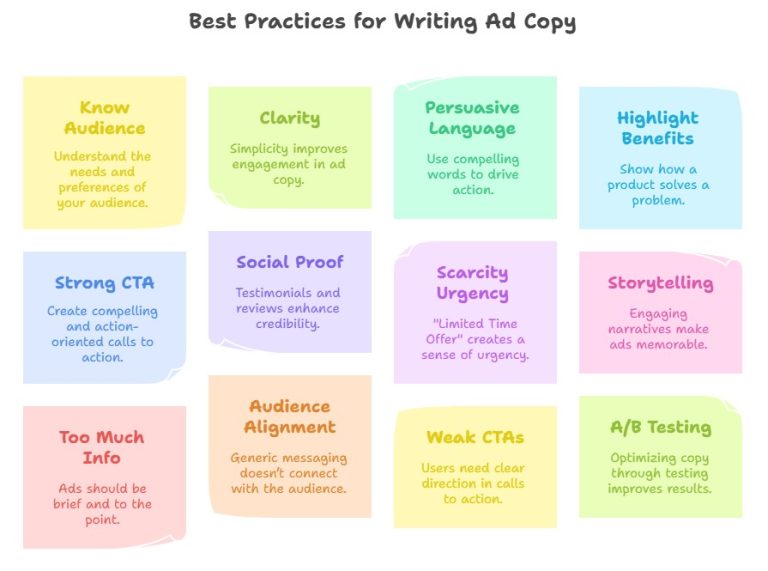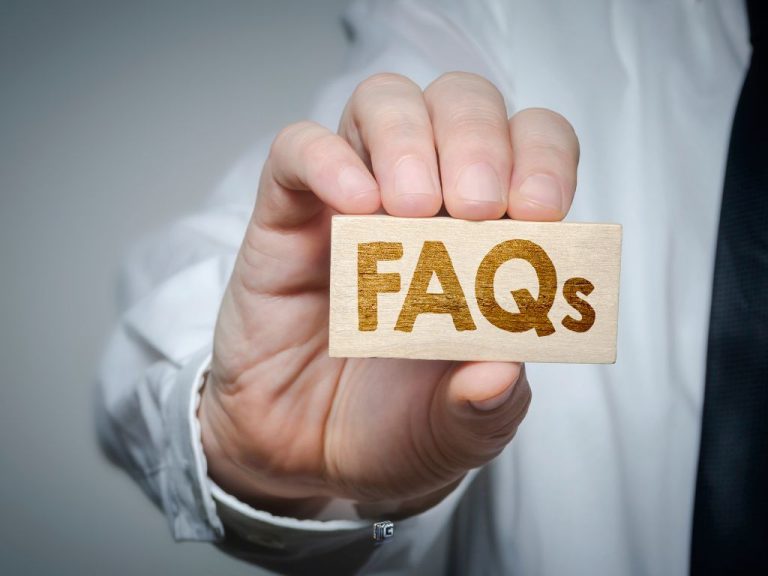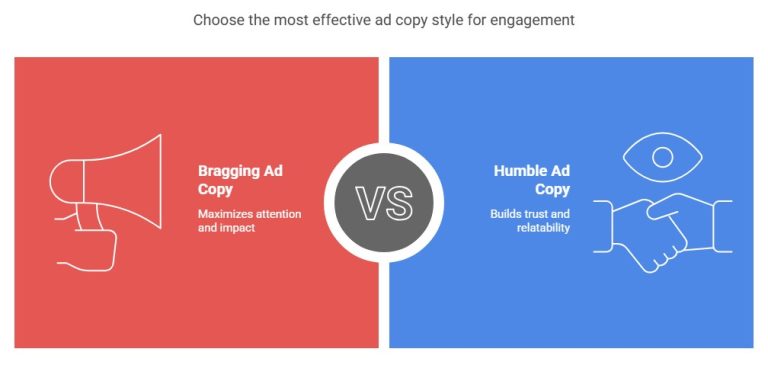Introduction
Ad copy is the written content in advertisements designed to persuade users to take action, such as clicking, purchasing, or signing up.
It plays a key role in marketing by influencing consumer decisions and reinforcing brand identity. The term “copy” originates from traditional advertising, referring to the text used in print ads and commercials.
Well-crafted ad copy can be the deciding factor between a user engaging with an ad or scrolling past it.
For a full glossary of marketing terms, visit our Marketing Glossary.

Ad Copy: The Role of a Copywriter
A copywriter crafts persuasive and engaging messages that resonate with the target audience.
Unlike general content writing, which focuses on informing or entertaining, ad copywriting is about prompting action.
Skilled copywriters analyze customer behavior, use emotional triggers, and align messages with brand goals.
Notable copywriters like David Ogilvy and Eugene Schwartz shaped modern advertising with strategic messaging that drove conversions.
Understanding the AIDA Formula for Ad Copy
AIDA is a widely used framework in advertising:
- Attention: Capture interest with a strong headline.
- Interest: Address a need or pain point.
- Desire: Showcase benefits that create urgency.
- Action: Provide a clear CTA like “Shop Now” or “Learn More.”
Types of Ad Copy
Different platforms require different ad copy approaches:
- Google Search Ads: Keyword-focused, clear, and actionable.
- Display Ads: Engaging visuals with concise text.
- Facebook & Instagram Ads: Conversational or storytelling-based messaging.
- LinkedIn Ads: Professional, credibility-driven copy for B2B audiences.
- Twitter & TikTok Ads: Short, punchy, and engaging messaging.

Best Practices for Writing Effective Ad Copy
- Know your audience: Understand their needs and preferences.
- Keep it clear and concise: Simplicity improves engagement.
- Use persuasive language: Words like “exclusive” and “proven” drive action.
- Highlight benefits, not just features: Show how a product solves a problem.
- Craft a strong CTA: Make it compelling and action-oriented.
The Science Behind Great Ad Copy
Effective ad copy taps into consumer psychology:
- Social proof: Testimonials and reviews enhance credibility.
- Scarcity & urgency: “Limited Time Offer” creates urgency.
- Storytelling: Engaging narratives make ads memorable.
Mistakes to Avoid in Ad Copywriting
- Too much information: Ads should be brief and to the point.
- Lack of audience alignment: Generic messaging doesn’t connect.
- Weak or unclear CTAs: Users need clear direction.
- Ignoring A/B testing: Optimizing copy through testing improves results.
Writing Ad Copy for Different Platforms
Each platform has unique requirements:
- Google Ads: Focus on clarity and keyword alignment.
- Facebook & Instagram Ads: Test short and long-form copy.
- LinkedIn Ads: Maintain a professional, value-driven tone.
- Twitter & TikTok Ads: Keep it short, engaging, and trend-relevant.
Case Studies & Real-World Examples
- Competitive ad copy: How brands outperform rivals.
- Conversational ad copy: A relatable tone increases engagement.
- Bragging vs. humble ad copy: Finding the right balance.
- LinkedIn success stories: How storytelling builds credibility.

Frequently Asked Questions (FAQs)
1. What is ad copy?
Ad copy refers to the written content in advertisements designed to persuade users to take action, such as clicking, purchasing, or signing up. It’s a key component of marketing that influences consumer decisions and brand perception.
2. How do I write ad copy that converts?
To write high-converting ad copy:
- Start with a compelling headline to grab attention.
- Address a pain point or desire to spark interest.
- Highlight the benefits, not just features.
- Create a sense of urgency or exclusivity.
- Use a clear call to action (CTA) like “Shop Now” or “Get My Free Guide.”
3. What are the key elements of a great ad copy?
Effective ad copy typically includes:
- A strong hook that grabs attention.
- A benefit-driven message that resonates with the audience.
- Emotional triggers like FOMO, social proof, or storytelling.
- A clear and compelling CTA that tells users what to do next.
4. How long should ad copy be?
It depends on the platform:
- Google Search Ads – Short and keyword-focused (30-90 characters per line).
- Facebook & Instagram Ads – Short to medium-length (125-200 characters).
- YouTube & Video Ads – Engaging and script-friendly (1-2 sentences per scene).
- LinkedIn Ads – Professional and credibility-driven (50-150 words).
5. What’s the best CTA for ad copy?
A strong Call to Action (CTA) should be clear, direct, and action-driven. Examples:
- E-commerce: “Shop Now,” “Claim Your Discount,” “Limited Offer – Buy Today.”
- Lead Generation: “Get My Free Guide,” “Sign Up in 30 Seconds,” “Book a Free Call.”
- B2B Services: “Start Your Free Trial,” “Get a Custom Quote,” “See It in Action.”
6. What are the biggest mistakes in ad copywriting?
Avoid these common mistakes:
- Too generic messaging – Be specific about the value.
- Weak or missing CTA – Tell the audience what to do next.
- Overloading with information – Keep it concise and impactful.
- Not optimizing for mobile – Ads must be clear on all devices.
- Ignoring A/B testing – Always test different versions to find the best performer.
7. How do I test if my ad copy is effective?
The best way to measure ad copy performance is A/B testing:
- Run two versions of the same ad with different wording.
- Track key metrics like Click-Through Rate (CTR), Cost Per Click (CPC), and Conversion Rate.
- Optimize based on what drives the most engagement and sales.
8. Can AI write effective ad copy?
AI can generate ad copy, but human creativity is still essential. AI tools like ChatGPT can help with:
- Brainstorming headline ideas.
- Creating multiple variations for A/B testing.
- Generating ad copy quickly for different platforms.
However, refining AI-generated copy with human emotion and brand voice leads to better results.
9. How do I optimize ad copy for SEO?
For search ads and SEO-driven campaigns, ensure:
- Keyword relevance – Include high-intent search terms.
- Clarity – Match ad copy with what users are searching for.
- Concise messaging – Front-load important information.
- Strong CTA – Encourage immediate action.
10. Where can I learn more about ad copywriting?
To master ad copy, check out:
- Books like Ogilvy on Advertising by David Ogilvy.
- Online courses on Udemy, HubSpot, or Google Skillshop.
- Our in-depth Affiliate Marketing Guide for high-converting ad strategies.

Conclusion
Great ad copy persuades, informs, and drives action. Testing and refining messaging leads to better results.
Whether for search ads, social media, or B2B campaigns, the right words make a difference in achieving marketing success.
Next, you might want to read our affiliate marketing guide.
0 Comments